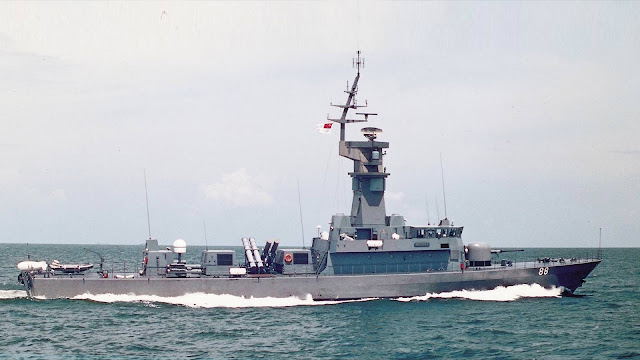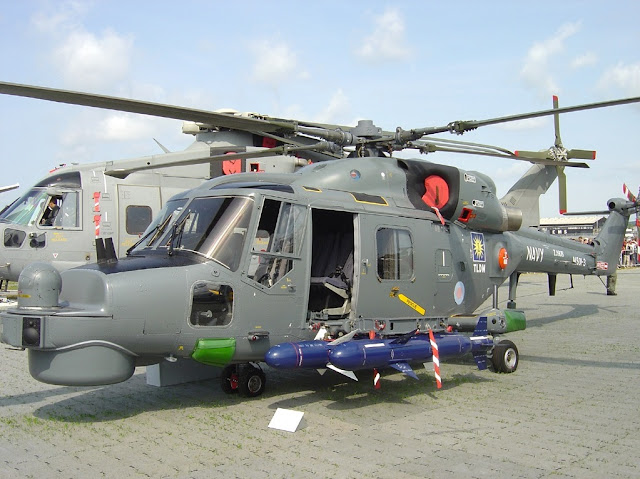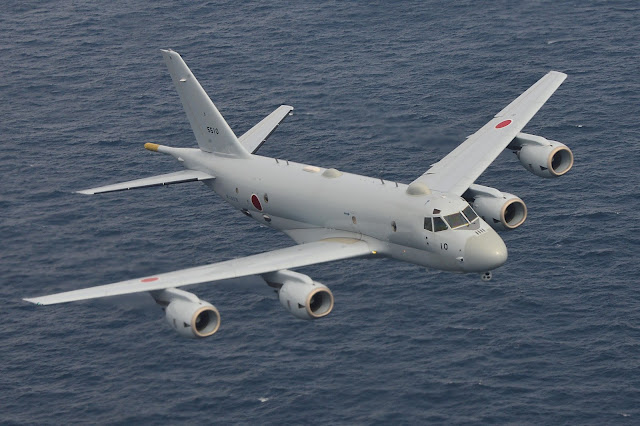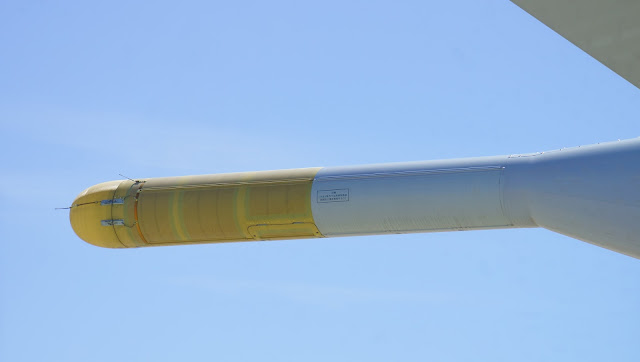 |
| Harpoon Block II. Image : Boeing |
On 15th July 2020 Singapore Technologies Engineering ( STE ) announced that its Land Systems division has signed an agreement with Israel Aerospace Industries ( IAI ) to set up a joint venture in Singapore, with each having a 50 percent share. The joint venture, named Proteus Advanced Systems, will leverage the strengths and track record of its parent companies to market and sell advanced naval missile systems, including a next generation anti-ship missile ( AShM ) system.
Under its Land Systems arm, STE manufactures an entire range of NATO-standard ammunition from the humble 5.56mm ball M193 round to 155mm artillery shells but anti-ship missiles are definitely not its forte. IAI on the other hand can be considered the pioneer in anti-ship missiles having developed the very successful and war-proven Gabriel missile since 1970.
As revealed by STE to Defense News, it appears that the two defense giants have been collaborating to develop a new generation AShM known as Blue Spear for a few years. Also known as 5G SSM ( 5th generation surface-to-surface missile ), Blue Spear " is an anti-ship missile system that introduces an advanced and novel approach which addresses the challenges of the modern naval arena for years to come ".
STE's role in the development of Blue Spear includes the design, development and production of major subsystems like the booster motor and warhead. It claimed that the development of Blue Spear and the joint venture was a commercially driven initiative by both companies and is " not driven by any ongoing customer requirement". Or is it? Which of STE or IAI's customers could have a requirement for and could afford an advanced AShM system? What is the best way to market a new weapon system to international customers?
The parent companies of Proteus Advanced Systems are either completely state-owned ( IAI ) or government-linked ( STE ). Although STE is a publicly listed company on the Singapore Stock Exchange, its most substantial shareholder is Temasek Holdings, the investment arm of the Singapore government, whom as of 1 Apr 2020 has a 52.13% share through direct and deemed interests. STE's most loyal and important customer of course is none other than the Ministry of Defense of Singapore. Similarly, 20% of IAI's sales goes to the Israeli defense ministry and the State of Israel is by no doubt IAI's most important customer.
With regards to the development of Blue Spear, it is probably of no coincidence that both the Israeli Navy and the Singapore Navy are equipped with the ageing Harpoon AShM and will soon have to decide if they should be upgraded to the latest standards or to field a completely new design. The joint venture suggests that the latter is more likely the case.
 |
| Stealth frigate RSS Intrepid fires Harpoon during Ex Pacific Griffin 2019 Photo : Mindef |
The Harpoon In The RSN
The Harpoon is an all-weather, sub-sonic, sea-skimming, over-the-horizon, fire-and-forget anti-ship missile developed and manufactured by McDonnell Douglas ( now Boeing ). It can be considered one of the most commercially successful AShM in history with over 7500 units produced since it came into service with the US Navy in 1977. It has been sold to 31 countries apart from the United States.
The versatility of the Harpoon missile is such that it can be surface-launched, submarine-launched or air-launched, with the variants designated RGM-84, UGM-84 and AGM-84 respectively.
Many factors contributed to the Harpoon's success of which I will mention two. Focusing on the surface-launched version alone, in the early years, it out-ranged its contemporaries with its over-the-horizon capability with a published range of 70nm ( 126km ). Its relative compactness means that it can be launched from canisters bolted to the upper deck of almost any surface combatant from fast attack crafts to battleships.
 |
| RSS Victory in its original configuration with Harpoon, torpedo tubes, variable depth sonar and angled auxiliary mast. Photo : Lurssen |
Indeed one of the reasons why the Republic of Singapore Navy ( RSN ) acquired its Victory-class missile corvettes ( MCV ) which are equipped with the Harpoon AShM in the late 1980s was because it found itself having to keep Singapore's sea lines of communication open out to at least a thousand kilometers but its existing Sea Wolf - class missile gunboats ( MGB ) with Gabriel AShM out-ranged by its neighbours. It would later upgrade the MGB to carry a mix of 2 Gabriel and 2 to 4 Harpoon AShM. With a full load displacement of 254 tons and a length of 45 meters, the Sea Wolf - class MGB was probably one of the smallest platform to ever accommodate the Harpoon missile.
 |
| Upgraded Sea Wolf class MGB with Harpoon and Gabriel. Photo : Mindef |
With the Harpoon AShM, the RSN acquired the beyond-the-horizon capability in anti-surface warfare ( ASuW ) for the first time and for a while it gave the RSN the upper hand when it came to the range of the various AShM among the regional navies. This technological edge however gradually became eroded with the passage of time with the emergence of newer and more advanced AShM in the inventories of its regional peers.
The MGBs were eventually decommissioned in 2008 and were replaced by the Formidable-class stealth frigates which were also armed with the Harpoon missile as their primary ASuW strike weapon. The Harpoon variant on these advanced frigates are sometimes stated as the RGM-84C ( Block 1B ) which are really ancient but are likely to be the marginally more advanced RGM-84D ( Block 1C ) as shown in the photo from MINDEF below. If indeed this were to be true, then the RSN would very soon need to either upgrade these old Harpoons to the latest Block II+ ER standard or risk facing obsolescence.
 |
| RSS Stalwart executing a designated time-on-target Harpoon firing during Ex Pacific Griffin 2017. RSS Supreme fired the other Harpoon. Photo : Mindef |
 |
| Enlarged from photo above : RGM-84D-3 |
It is worth noting that more than a decade had passed since the commissioning of the stealth frigates and they will soon approach the mid-point of their life-cycle, the perfect time to have them acquire new capabilities via some service life extension program ( SLEP ). It has been planned as such even before the frigates have been commissioned ( see image below ).
 |
| Excerpt from keynote address by Mr Peter Ho, Permanent Secretary ( Defense ) at the Naval Platform Technology Seminar 2003. Source : National Archives of Singapore. |
After serving in the RSN for thirty years, the Victory-class MCVs are themselves due for retirement by 2025, to be replaced by a new class of locally designed and constructed vessels known as the Multi-Role Combat Vessel ( MRCV ) and these will need to be equipped with modern AShM as well.
So to regain the technological edge it used to have against its regional near-peer rivals the RSN clearly has a need for an advanced surface strike weapon for its frigates and its next-generation corvette replacements in the next 5 to 10 years. For that the RSN has several broad options : upgrade its existing stock of old Harpoons to the latest standard, buy a new missile system off-the-shelf, or opt for an indigenous design customized for itself. Each option has its own merits and risks.
 |
| RGM-84N Block II Harpoon skimming the waves. Image : Boeing |
Upgrading the Harpoon
Having been designed in the mid-sixties and first deployed in the late seventies, the Harpoon missile might be getting old but it has an undeniable strength - reliability. It simply works as advertised, each time and every time.
During RIMPAC 2018, six Harpoon missiles had been fired against two decommissioned USN ships from various platforms including air, surface and sub-surface assets from several participating nations. All six missiles hit their targets as intended. Especially interesting was the UGM-84 encapsulated harpoon launched by the nuclear attack submarine USS Olympia ( SSN-717 ). The UGM-84 had been taken off the regular armament of USN attack submarines for the past twenty years in favour of the Mk 48 Advanced Capability ( ADCAP ) heavyweight torpedo as the boat's preferred anti-ship weapon. Even after two decades of storage, the Sub-Harpoon scored a hit against the landing ship tank USS Racine. An AGM-84 air-launched Harpoon fired from an Australian P-8A Poseidon maritime patrol aircraft also struck the LST hulk.
 |
| Simultaneous time-on-target Harpoon firing, RSS Tenacious RIMPAC 2018. Photo : MINDEF |
Notably, the RSN's stealth frigate RSS Tenacious carried out a simultaneous time-on-target Harpoon firing with two missiles aimed at the ex-USS McKlusky, an Oliver Hazard Perry - class frigate. Both missiles happened to hit the hulk at the waterline which was rather unusual for the Harpoon missile. As a result the hulk sank much faster than anticipated and several other naval combatants were deprived of their chance to participate in the sink exercise ( SINKEX ). Through inference the remaining two missiles would have come from a participating USN P-8A.
As a result of this positive demonstration of the Harpoon's reliability, even the USN is showing renewed interest in upgrading the Harpoon missiles in its inventory and the UGM-84 might once again be part of the SSN's offensive weaponry.
The USN has not procured new Harpoon missiles for many years and all its latest Block II Plus Extended Range Harpoons are upgraded from its existing pool of RGM-84D ( Block 1C ) missiles. Each conversion kit from Boeing Defense and Aerospace would cost the US government perhaps $268000, a paltry sum compared to the cost of manufacturing a brand new Block II+ ER missile which is probably in the region of several million. For example Finland's 2018 request for 100 RGM-84Q-4 ( Block II+ ER ), 12 RGM-84L ( Block II ), 12 Block II+ ER upgrade kits, 4 RTM-84Q and 4 RTM-84L together with all the necessary spares, repair equipment, training and support was estimated to cost US$622 million.
Compared with the older Harpoon versions, the most advanced II+ER has a lighter but more lethal warhead and a more fuel efficient turbojet engine that together almost doubled its range. It also inherited the low cost inertial measurement unit from the JDAM program and the GPS guidance kit of the SLAM-ER missile. A net-enabled data-link enables the missile to receive in-flight targeting updates and there is also enhanced resistance against electronic countermeasures. So not only is its range increased, its connectivity and survivability has also been improved significantly.
Should the RSN choose to upgrade its RGM-84D Harpoons to the latest Block II+ ER standard, there will be considerable cost savings since it has a ready pool of Block 1C Harpoons to work on with all the necessary maintenance, repair, training and support infrastructures. But how many new tricks can you teach an old dog? One of the negative attributes of the Harpoon not amendable through the usual upgrades is its sub-sonic speed in this modern era of super-sonic AShMs. Being slower means giving the enemy combatants more reaction time to deploy countermeasures and initiate effective evasive maneuvers. It is also less stealthy compared to more recently introduced AShMs like the AGM-158C LRASM and can be detected more easily, reducing its chance of hitting its target. The need for a proprietary launcher for the Harpoon missile alone which cannot be loaded with other shipboard missile types means less flexibility in deployment and dedicated instead of shared resources and that can also work against the upgrade-harpoon option.
 |
| IAI Gabriel V AShM. Image : Finnish Navy |
Off-The-Shelf Solutions
After half a century of evolution, there is currently no shortage of modern AShMs that can give the ageing Harpoon missile a run for its money. In fact many do out perform the Harpoon in one way or other. The Norwegian Kongsberg Naval Strike Missile and the IAI's Gabriel V AShM are two such examples contemporary sub-sonic anti-ship missiles. Examples of supersonic AShMs include Taiwan's Hsiung Feng III and the vertical launched Brahmos which is of Indian and Russian origin.
Buying mature anti-ship missile systems that have already completed their development cycles offers the lowest exposure to product development risks. It may result in rapid system integration and mitigation of any existing capability gap. However such ready solutions may not always be an exact match for the sometimes unique operational needs of the host country.
Singapore for instance has the great fortune of being strategically located along an important maritime route linking the Indian Ocean and the Pacific Ocean where an estimated 5.3 trillion dollars of trade transit annually. It is the world's second busiest container port and is surrounded by shallow seas and numerous islands. Access to the Port of Singapore is via the narrow and busy deep water passage known as the Straits of Singapore where an estimated 2000 vessels of all types transit daily. Together with the equally busy Straits of Malacca to its north-west, these are major maritime choke points where the risk of piracy and the risk of collision between vessels are high. To conduct maritime interdiction operations in such congested littoral environments would be understandably challenging. Yet the RSN also has to be equally proficient in open-ocean operations in deep water environments such as the South China Sea, since its raison d'etre is to keep Singapore's sea lines of communications open. To find an anti-ship missile that can excel in both littoral and open-ocean domains may not be easy and since the RSN has such unique requirements, it might have decided to develop its own next-generation AShM rather than source for a ready made system.
 |
| Extreme congestion in Singapore Strait. Image : Marine Traffic |
5G SSM
To have local defense engineers research and co-develop the next generation advanced anti-ship missile for Singapore probably made the most sense for the reasons mentioned above. Apart from ensuring complete customization for its operational requirements, designing and producing an indigenous AShM can also benefit the local state-linked defense industry by diversifying its product portfolio and allowing it to nurture new talents and acquire new design and manufacturing capabilities.
The setup of a joint venture between the Israeli and Singapore defense giants to market the 5G SSM and the tacit admission that the collaboration had been ongoing for a few years probably means that the missile is already in an advance stage of product development. As usual it is a matter of selecting the best time to make the official announcement so as to avoid alarming Singapore's regional peers least it triggers an arms race which is likely inevitable in the long run. Even then, the announcement was extremely low key appearing only on the webpages of IAI and STE and in a short article in the Straits Times of Singapore. So far almost nothing is known about the Blue Spear missile except it has advanced features to overcome the challenges of modern naval warfare. Here are some characteristics that the 5G SSM could possibly have.
Range - likely to be significantly greater than that of the current RGM-84D in the RSN's inventory to keep pace with the NSM, MM-40 Block 3, Otomat Mk2 and even the supersonic Yakhont, in service with regional navies. 200 to 250km is a reasonable estimate.
Speed - Likely to remain high sub-sonic rather than super-sonic considering that the RSN's area of operation included congested littoral environment.
Survivability - Must include low observability features with reduced radar cross section and infra-red signatures to decrease the detection rate and have enhanced electronic counter countermeasures to defeat the enemy ship's soft-kill and hard-kill capabilities.
Connectivity - Secure 2-way data-link to enable mid-flight course correction and to receive targeting updates from a variety of sources including surface combatants, maritime patrol aircrafts and unmanned aerial vehicles.
Accuracy - Possibly an AI selectable hybrid terminal guidance combining active and passive modes
Lethality - Advanced warhead design effective against both ship hulls and hardened land installations.
Versatility - Equally adept in littoral and open-ocean environments with secondary land attack capabilities.
Deployability - Preferably adaptable for both large and small vessels, compatible with both vertical launch systems and canister launchers.
Whatever its final form takes, the Blue Spear has to be far superior to the Harpoon Block 1C that it will presumably replace, by virtue of its adoption of the latest technologies which was not available to the designers of the Harpoon four decades ago. It should also have better performance compared to the most advanced Harpoon Block II+ER. With this rationale the RSN will probably be better off developing a cutting edge new generation AShM rather than upgrading its old Harpoons.
Having the Singapore and Israeli Navies adopt the 5G SSM can potentially make it easier to market the missile to other international customers. Endorsement of the weapon by two of the world's highly regarded navies is the best advertisement for this new missile system. While the Harpoon missile has served the RSN well for the past three decades, without an upgrade, its remaining days might be numbered. It might quietly fade into history in the next five to ten years as the Victory-class MCV gets decommissioned and the Formidable-class frigates get put through their SLEP, swapping the Harpoon for the Blue Spear.
Proteus Advanced Systems
Incidentally, in Greek mythology, Proteus is the oracular god of the sea who can predict the future, but will only do so when held captive. He is elusive and will constantly change his shape in order to avoid being captured. He is the herdsman of the sea beasts, one of several deities whom Homer refers to as " Old Man Of The Sea ". From the capability of Proteus to assume many different forms comes the adjective protean, meaning able to change frequently or easily, with the connotation of versatility, adaptability and flexibility. By naming their joint venture Proteus Advanced Systems what might IAI and STE be hinting at, if any?
Update 10th Sep 2020
I have received information that the scheduled retirement of the Victory-class missile corvettes have been pushed back by a good 5 years, from the original 2025 to 2030. This will be the final and maximum extension of service. The MLU carried out around 2010 was supposed to extend the service life of the MCV by 20 years at the most.
Presumably the MRCV project will also be delayed by 5 years since they are meant to replace the MCV.
So it would seem that the Harpoon missile will continue to reign in the RSN for another decade .... but highly unlikely beyond that.
















































